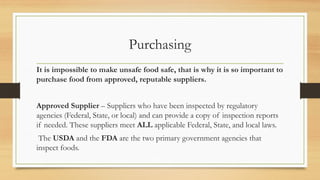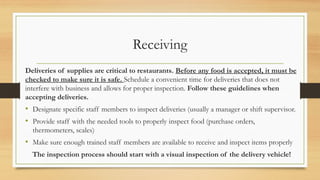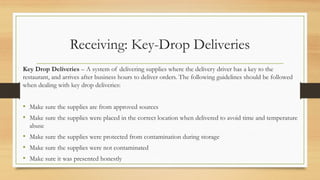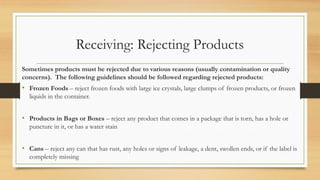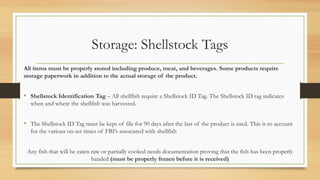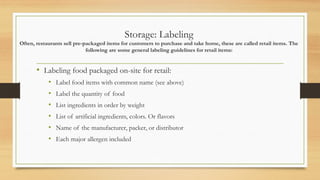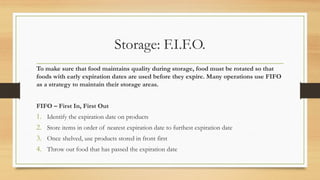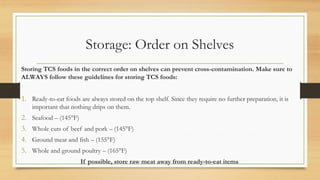National Restaurant Association ServSafe Chapter 5
- 1. ServSafe Ch. 5 The Flow of Food: Purchasing, Receiving, and Storage
- 2. Purchasing It is impossible to make unsafe food safe, that is why it is so important to purchase food from approved, reputable suppliers. Approved Supplier – Suppliers who have been inspected by regulatory agencies (Federal, State, or local) and can provide a copy of inspection reports if needed. These suppliers meet ALL applicable Federal, State, and local laws. The USDA and the FDA are the two primary government agencies that inspect foods.
- 3. Receiving Deliveries of supplies are critical to restaurants. Before any food is accepted, it must be checked to make sure it is safe. Schedule a convenient time for deliveries that does not interfere with business and allows for proper inspection. Follow these guidelines when accepting deliveries. ? Designate specific staff members to inspect deliveries (usually a manager or shift supervisor. ? Provide staff with the needed tools to properly inspect food (purchase orders, thermometers, scales) ? Make sure enough trained staff members are available to receive and inspect items properly The inspection process should start with a visual inspection of the delivery vehicle!
- 4. Receiving: Key-Drop Deliveries Key Drop Deliveries – A system of delivering supplies where the delivery driver has a key to the restaurant, and arrives after business hours to deliver orders. The following guidelines should be followed when dealing with key drop deliveries: ? Make sure the supplies are from approved sources ? Make sure the supplies were placed in the correct location when delivered to avoid time and temperature abuse ? Make sure the supplies were protected from contamination during storage ? Make sure the supplies were not contaminated ? Make sure it was presented honestly
- 5. Receiving: Rejects Occasionally the supplies that are delivered do not meet quality standards and must be returned. If an item needs to be returned, the following are recommendations for returning supplies: ? Set the item aside so that everyone knows it is not to be used ? Tell the delivery driver why the item is being returned ? Make sure to get a signed credit slip from the delivery driver before they leave the store ? Record the return in a receiving/return log-book
- 6. Receiving: Product Recalls Products can be recalled by the government of the manufacturer. The two most common reasons for a recall is the food is suspected of being contaminated or the item is mislabeled. ? Identify the recalled items from the inventory ? Remove the item from the inventory and place it in a separate, secure location ? Label the product in a way so that everyone knows it should not be used ? Refer to the recall information for info on what to do with the recalled item
- 7. Receiving: Checking Temperatures When checking the deliveries of temperature-sensitive items, make sure to properly check the temperature of the product: ? Meat, fish, and poultry – Insert a bi-metallic stem thermometer or a penetration probe into the thickest part of the food to take the internal temperature ? ROP Foods (Reduced Oxygen Packaging) – Place two packages on top of each other and insert a bi-metallic or penetration probe between the two packages to take the temperature. Make sure not to puncture the packaging) ? Packaged Food (milk, sour cream, yogurt) – Open one of the packages and insert a bi-metallic or penetration probe into the product
- 8. Receiving: Checking Temperatures Deliveries of cold products must meet the following internal temperature limits: ? Cold Food - <41°F ? Live Shellfish - <50°F ? Shucked Shellfish - <45°F *must be cooled to <41°F within 4 hours of receiving ? Milk - <45°F ? Shell Eggs - <45°F ? Hot Food - >135°F ? Frozen Food – make sure frozen products are still frozen
- 9. Receiving: Rejecting Products Sometimes products must be rejected due to various reasons (usually contamination or quality concerns). The following guidelines should be followed regarding rejected products: ? Frozen Foods – reject frozen foods with large ice crystals, large clumps of frozen products, or frozen liquids in the container. ? Products in Bags or Boxes – reject any product that comes in a package that is torn, has a hole or puncture in it, or has a water stain ? Cans – reject any can that has rust, any holes or signs of leakage, a dent, swollen ends, or if the label is completely missing
- 10. Storage: Shellstock Tags All items must be properly stored including produce, meat, and beverages. Some products require storage paperwork in addition to the actual storage of the product. ? Shellstock Identification Tag – All shellfish require a Shellstock ID Tag. The Shellstock ID tag indicates when and where the shellfish was harvested. ? The Shellstock ID Tag must be kept of file for 90 days after the last of the product is used. This is to account for the various on-set times of FBI’s associated with shellfish Any fish that will be eaten raw or partially cooked needs documentation proving that the fish has been properly handed (must be properly frozen before it is received)
- 11. Receiving: Rejecting Products Products should also be rejected if quality standards are not met. Reject food for the following reasons: Appearance – reject food that is moldy or has an abnormal color, as well as products that show signed of contamination Texture – reject meats and produce that are slimy, sticky, wet, dry, too hard, too soft, and over and under-ripened Odor – reject food that has an unpleasant odor
- 12. Storage: Labeling Proper labeling is very important in the preventing of contamination and allergic reactions. The following are some general labeling guidelines: ? Labeling food for on-site use: ? All items that are not in original containers must be labeled ? Food labels should include the common name of item, not brand name (ex. tomato sauce, not Ragu) ? A label is not needed if the product is clearly identified (ex. bananas, eggs)
- 13. Storage: Labeling Often, restaurants sell pre-packaged items for customers to purchase and take home, these are called retail items. The following are some general labeling guidelines for retail items: ? Labeling food packaged on-site for retail: ? Label food items with common name (see above) ? Label the quantity of food ? List ingredients in order by weight ? List of artificial ingredients, colors. Or flavors ? Name of the manufacturer, packer, or distributor ? Each major allergen included
- 14. Storage: Expiration Dates TCS foods that have been prepared (ready-to-eat) have an expiration limit (shelf life) of 7 days if the product has been kept below 41°F. This basically means that left-overs should not be eaten after they have been stored for longer than 7 days. The 7-day period begins on the day the original product was made. If additional ingredients are added to the product (ex. Meatballs added to tomato sauce) the expiration date remains the original date.
- 15. Storage: Refrigeration and Freezer Tips Refrigerators and freezers are vital for the proper storage of foods that are temperature sensitive. To ensure that refrigerators and freezers work efficiently, follow these recommendations: ? Store TCS foods below 41?F or higher than 135?F ? Store frozen foods at temperatures that will keep the food frozen ? Make sure refrigerators and freezers have at least one temperature measuring device and monitor the temperatures regularly ? Do not over-crowd refrigerators and freezers, this makes the motor work harder to maintain the correct temperatures and it also limits air flow ? Do not line the shelves of a refrigerator or freezer. This limits air flow and can lead to contamination ? Monitor temperatures regulary
- 16. Storage: F.I.F.O. To make sure that food maintains quality during storage, food must be rotated so that foods with early expiration dates are used before they expire. Many operations use FIFO as a strategy to maintain their storage areas. FIFO – First In, First Out 1. Identify the expiration date on products 2. Store items in order of nearest expiration date to furthest expiration date 3. Once shelved, use products stored in front first 4. Throw out food that has passed the expiration date
- 17. Storage: Order on Shelves Storing TCS foods in the correct order on shelves can prevent cross-contamination. Make sure to ALWAYS follow these guidelines for storing TCS foods: 1. Ready-to-eat foods are always stored on the top shelf. Since they require no further preparation, it is important that nothing drips on them. 2. Seafood – (145°F) 3. Whole cuts of beef and pork – (145°F) 4. Ground meat and fish – (155°F) 5. Whole and ground poultry – (165°F) If possible, store raw meat away from ready-to-eat items
- 18. Storage: General Information To prevent cross-contamination follow these general storage guidelines: ? Store all items in designated areas ? NEVER store food near locker rooms, restrooms or garbage areas, mechanical rooms, under sewer lines or plumbing, under stairwells ? Store all items off at least 6 inches off the ground ? Try to store items in original packaging ? Store food in containers that are leak-proof and approved for food service ? NEVER use empty chemical containers to store food ? Clean storage areas often including the shelves or racks ? Store dirty linens away from food

